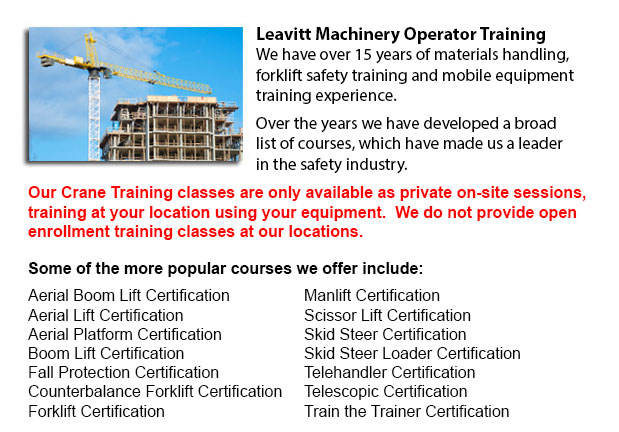
Hamilton Overhead Crane Safety Training - Overhead crane safety training equips operators with skills and knowledge regarding crane safety measures, materials handling, accident avoidance, and machine and stock protection. Trainees would learn the kinds of overhead cranes, their capabilities and their uses in different industry environments. For operators who are licensed and trained, the shift in liability moves to the operator from the company. Thus, the program emphasizes individual operator responsibilities.
The operators in the overhead safety training course would be given instruction on the right methods for carrying out inspections: the more detailed in-depth inspection and the pre-shift inspection. These are critical daily routines which must be logged. Correctly recorded pre-shift inspections help to protect the company from liability in case of an accident. Pre-shift inspections also prevent accidents, damage and expensive repairs. Operators learn how to designate a specific person to carry out inspections, how to maintain the log book and how to report problems.
Each and every inspection should be documented and carried out regularly. Things which should be checked for possible concerns, comprise: increase in the throat opening, hooks for cracks, hoist ropes for corrosion, degree of twist, loss of diameter, worn wires, broken wires, bird caging and kinks, heat and chemical damage; chains for nicks and gouges, corrosion and cracks, twists, distortion, excessive wear, stretching, pits, damage from extreme heat.
Operators learn right rigging methods in this course. Rigging includes understanding the manufacturer's data plate, determining the material weight to be lifted, choosing the gear, and using safe practices to secure the load. The course include in detail the following: safe working loads, and the capacities of chains, ropes, hooks, shackles and slings.
It is vital to know who may operate the cranes at your facility, physical requirements of the job, and operator credentials required for permits and specialized tasks. Safety is a top priority when using in the vicinity of pedestrian traffic.
The responsibilities included in the safe crane use consists of checking for hydraulic leaks, undertaking visual inspections, testing the controls, checking the safety guards, examining the hook and hoist rope, limit switches and braking mechanisms. Right reporting methods are vital. These subject matters are all covered in depth in the course.
Right lifting and moving methods with cranes and hoists are covered in the program. Operators would become competent in hand signals. Training includes how to attach the load, raise the load, set the load, unhook the slings and abort a lift.
Moving the load includes a number of steps: stopping and starting procedures, guiding and controlling the load, working with signals and observing working conditions. Operators need to know how to proceed in case of a power failure. The course covers methods for removing the slings and lowering the load, parking the crane, storage equipment, and securing an outdoor and indoor crane.
-
Hamilton Aerial Platform Training
Hamilton Aerial Platform Training - Aerial hoists are able to accommodate various odd jobs involving high and hard reaching spaces. Often utilized to perform routine repair in structures with high ceilings, prune tree branches, hoist heavy shelving u... More -
Hamilton Heavy Equipment Operator Certification
Hamilton Heavy Equipment Operator Certification - The heavy equipment operator is a person who manipulates the controls and drives different kinds of big machinery. Heavy machinery is most commonly utilized on construction sites to deliver supplies t... More -
Hamilton Scissor Lift Ticket
Hamilton Scissor Lift Ticket - Scissor lifts have greatly benefited construction operations in view of the fact that the job that used to require much effort and lots of people, can now be completed utilizing the scissor lift truck and only one indiv... More -
Hamilton Forklift Certification Courses
Hamilton Forklift Certification Courses - Forklift certification courses really help to make sure that businesses utilizing forklifts, comply with the regional and local rules. The drivers of the forklift should undergo forklift certification prior t... More -
Hamilton Forklift Training Program
Hamilton Forklift Training Program - The forklift is a common powered industrial vehicle which is in wide use these days. They are occasionally called jitneys, hi los or lift trucks. A departments store would use the forklift to unload and load merch... More -
Hamilton Forklift License
Hamilton Forklift License - Obtaining a forklift license or forklift certification in North America would require the trainee to do hands-on training in addition to classroom instruction. The state, provincial and federal regulatory bodies are respon... More -
Hamilton Manlift Operator Certification
Hamilton Manlift Operator Certification - Our aerial lift and scissor platform training and certification empowers participants with a general understanding and knowledge of the efficient and safe use of "Power Operated Mobile Work Platforms," under... More -
Hamilton Forklift Operator Certification
Hamilton Forklift Operator Certification - Forklift operator certification is usually needed for employees working in industrial, warehouse or construction setting to guarantee the safe utilization of forklifts. Workplace training has to follow a met... More

Forklift Certification Hamilton
TOLL FREE: 1-888-254-6157
Hamilton, Ontario
forkliftcertificationhamilton.com
Email Us
About Us


